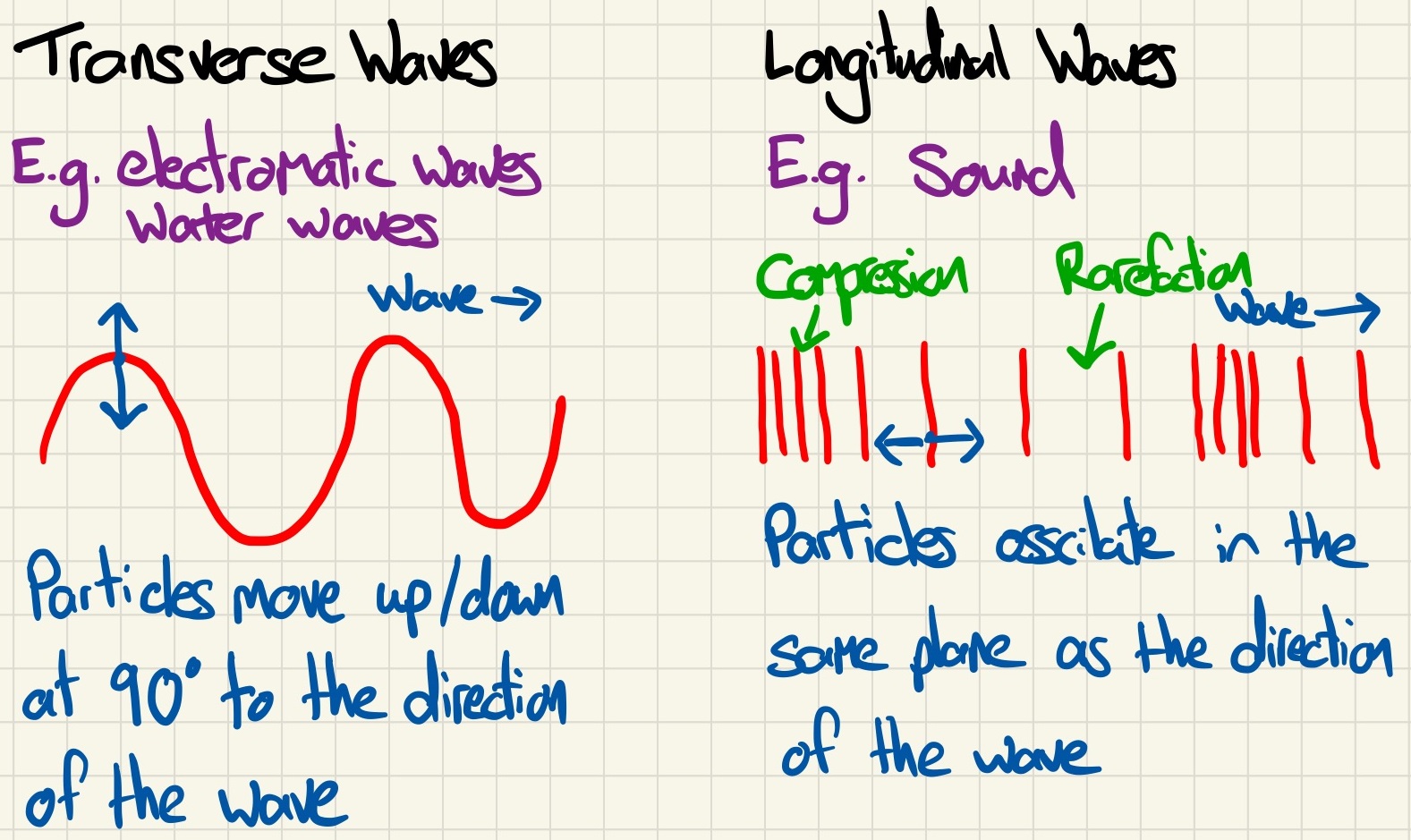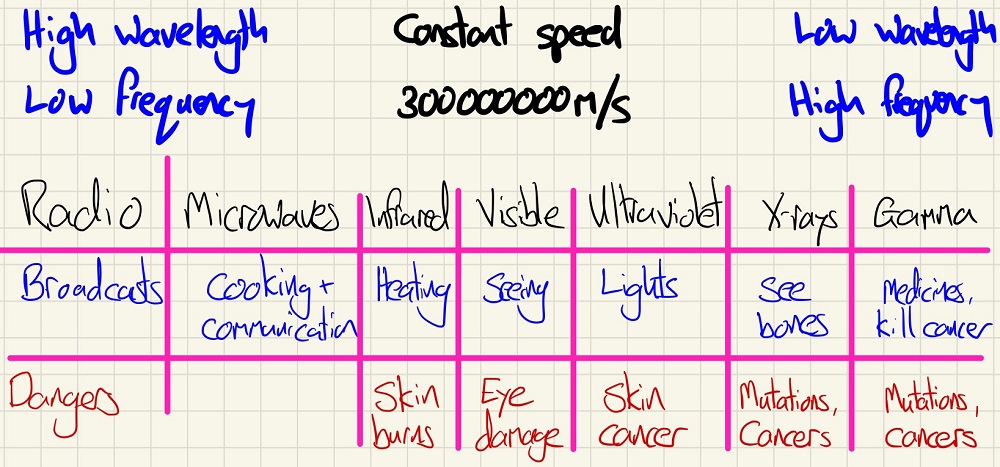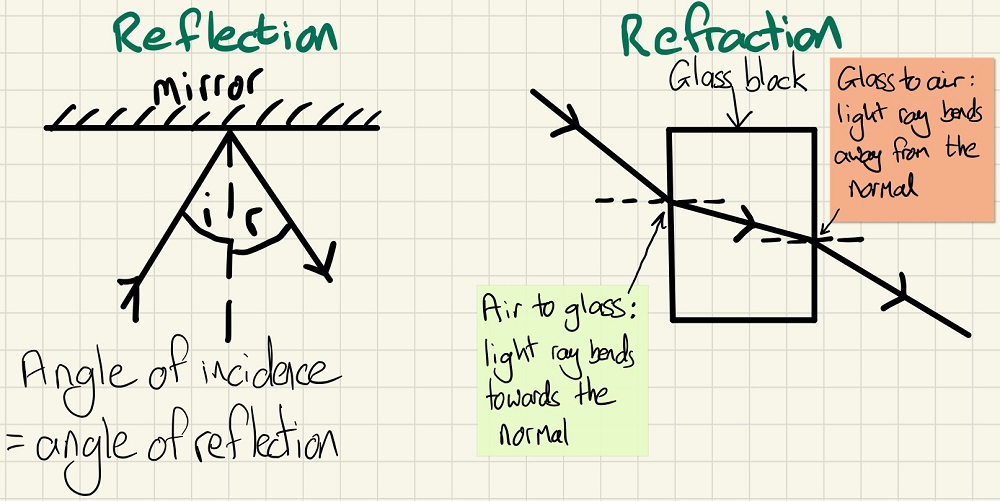Waves
What we are learning: (component knowledge)

Types of waves:
There are two types of waves to learn. Firstly there are longitudinal waves in which there are areas of compression and rarefaction. The movement or oscillation of particles is parallel to the direction of the wave. This is how sound travels, the air particles do not move from the source to your ear, they pass on the energy.
The second type is transverse waves, here the movement of particles is at 90° to the direction of the wave. Picture a pond after you have thrown in a pebble, the water at any point is moving up and down only but not moving towards the edge. It may appear that this is happening but if it was, the pond would empty as all of the water sloshed over the edges.
Remember that for both types, the wave moves along but the particles involved simply oscillate about a fixed point.

Properties of waves :
Look carefully at the diagram and make sure that you can pick up the wavelength and amplitude. Make sure that if you see another diagram of a wave form, you could label the peaks, troughs and work out the wavelength there too. It is worth mentioning that as the wavelength is the distance between two peaks (or troughs), to measure the wavelength more accurately, you could measure the instance between 5 and divide that by 5.
Period is the time (in seconds) it takes for one complete wave to pass. The relationship between period (seconds) and frequency (Hertz)is:
f = 1 / p and p = 1 / f
Calculate wave speed using v = f λ
Here wave speed (v in m/s), frequency (f in Hz) and wavelength (λ in metres).

The Electromagnetic spectrum:
All electromagnetic waves are transverse waves and they are said to be a part of a spectrum because they are not simply 7 types of wave, the change from one wave to another is very subtle. When the frequency increases, the wavelength decreases proportionally so that the wave speed is always constant. This speed for an electromagnetic wave is the speed of light or 300000000 m/s, better written as 3 x 108 m/s. This is shown by the formula that we have just met v = f λ.
This section contains lots of facts that you need to learn. This table is a good start but you need to know about the uses of them all with specific examples, dangers to living tissue and other facts such as: oscillations in an electrical circuit generate radio waves and linking radiation doses from X-rays to Sieverts delivered so that you can record and limit exposure. The radiation dose links well to the topic radiation, you need to explain how the badges worn by staff at nuclear power plants can warn them of over exposure work and the dangers of irradiation.

Reflection and refraction:
When a wave hits a reflective surface it is reflected. More precisely, it will reflect (angle of reflection) at the same angle it hit the surface (angle of incidence).
If a ray of light moves from a medium of one density into another, it will refract. If the wave moves from a low density to a higher density medium it will bend towards the normal and if it travels from a high to a low, it will bend away from the medium. Look at the diagram showing a ray passing through a glass bock. As long as the edges of the glass block are parallel, then the rays entering and leaving the block will also be parallel.
Key words/terms for this topic
Amplitude Angle of Incidence Angle of Reflection Compression Displacement Echo Electromagnetic Spectrum Frequency Gamma Rays Infrared Ionosphere Longitudinal Microwaves Period Radio waves Rarefaction Reflection Refraction Total Internal Reflection Transverse Ultraviolet Visible Light Wavefront Wavelength X-Rays
Quick Quiz:
What you need to know
The two types of waves are: transverse (up and down like the sea) and longitudinal (areas of compression and rarefaction like sound in air). You need to be able to describe the differences and similarities. Make sure that you know that air particles to not travel from a person's mouth to your ear when you hear them and that ripples in a pond move from the centre to the edge but the water molecules simply bob up and down.

Check that you can identify and label: Amplitude, wavelength, peaks, troughs. You need to be able to calculate frequency (1/time period) and use:

v=fλ

Wave velocity = frequency x wavelength

Make sure that you can describe how to test the speed of a sound wave as well as the speed of waves on water.

Electromagnetic waves are transverse waves that have a spectrum which you need to learn (radio waves to Gamma rays). Make sure that you know the uses and dangers of each type.

Use ray diagrams to show refraction when two different mediums meet (air to glass for example).

Required practical 20: Use equipment, such as a ripple tank to make observations and measurements of waves. Calculate wavelength and speed.

Extra topics needed for the Higher Tier papers:

Describe how different substances absorb, transmit, reflect and refract electromagnetic waves. refraction is caused by the waves changing speed in different mediums.

Radio waves can be produced by oscillations in electrical circuits. When they are absorbed, they can produce an alternating current of the same frequency

This page was updated on: 30th March 2024
